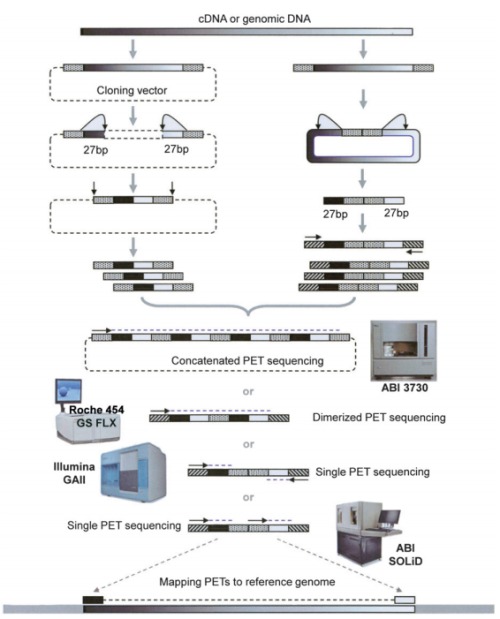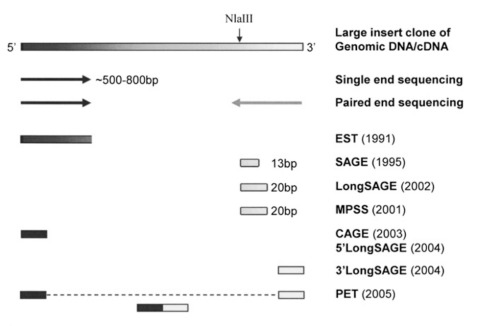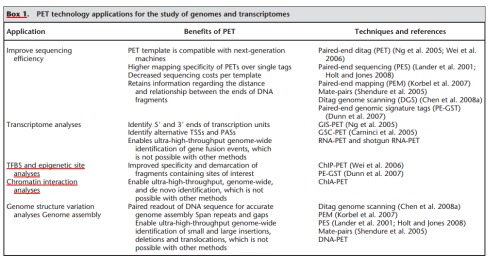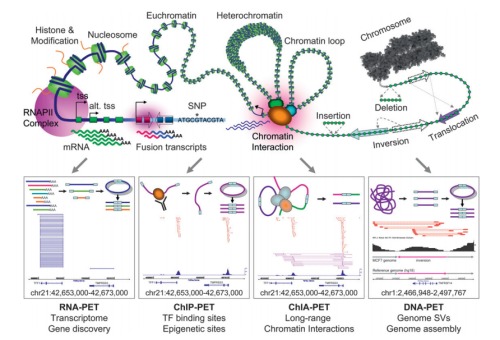PET概述
将由各种前期实验得到较长的DNA片段,取出其前后两个端的小段序列,称作Paired-End Tags, 将这些tags进行测序然后map到基因组上,从这两个tags就可以知道得到了基因组上哪段区域。PET可以有效降低冗余的数据量,从而降低测序费用,当然还有其他很多的优势将在下文中阐述。PET最主要的一个优势是可以发现DNA片段两端的链接关系,由这一特征可以用于进一步发现融合的转录子、基因组上的结构变异以及染色体上的远距离相互作用。
PET的原理与优势
PET的原理图见Fig.1。主要有两种策略,一种称为cloning-based,另一种称为cloning-free。
1. cloning-based
DNA片段首先被连接到克隆载体中,利用该克隆载体在DNA片段的两端加上含有特定的酶切位点(A)一中接头序列,这种接头序列应该在mapping到基因组的过程中可以指定它所连接的tag是哪一端,通过另一种酶将两端的tags之间的序列切掉。将载体转导到E.coli进行复制构建测序库,提取这种载体,用之前载体上特定的酶切位点A将这种tag-vector-tag的序列切下来进行测序。
2. cloning-free
将含有特定酶切位点(A)的寡居核苷酸序列街头加到DNA片段上,将带有接头的DNA片段环化,使两个end合到一起,然后用特定的酶去切位点A,得到测序文库。
Fig.1 PET的策略路线cloning-based的方法劳动、技术、投入密集度较高,其一个(可能是唯一)的优势是可以用转导后的E.coli保留目标DNA片段。上述实验的关键是特定的酶可以按照指定的bp长度切下目标tags和adaper。目前主要使用两个,MmeI(cuts DNA 18/20 bp downstrem of its recongnition site)和EcoP15I(cuts 25/27 bp downstream of its recognition site).
与PET技术相关的技术见Fig.2, 与其概念上相关的技术解释见Table.1。
Fig.2 发展史上的那些技术 Table.1 PET相关概念的技术PET技术的应用
PET技术的应用及其优势见Table.2,概括描述见Fig.3。
Table.2 PET的技术应用以及优势 Fig.3 PET技术应用于解决生物学问题Review原文请阅读:
本文参考来源:http://caoyaqiang.diandian.com/post/2012-09-18/40039409169
摘要预览:
Next-generation DNA sequencing of paired-end tags (PET) for transcriptome and genome analyses.
Fullwood MJ, Wei CL, Liu ET, Ruan Y.
Abstract
Comprehensive understanding of functional elements in the human genome will require thorough interrogation and comparison of individual human genomes and genomic structures. Such an endeavor will require improvements in the throughputs and costs of DNA sequencing. Next-generation sequencing platforms have impressively low costs and high throughputs but are limited by short read lengths. An immediate and widely recognized solution to this critical limitation is the paired-end tag (PET) sequencing for various applications, collectively called the PET sequencing strategy, in which short and paired tags are extracted from the ends of long DNA fragments for ultra-high-throughput sequencing. The PET sequences can be accurately mapped to the reference genome, thus demarcating the genomic boundaries of PET-represented DNA fragments and revealing the identities of the target DNA elements. PET protocols have been developed for the analyses of transcriptomes, transcription factor binding sites, epigenetic sites such as histone modification sites, and genome structures. The exclusive advantage of the PET technology is its ability to uncover linkages between the two ends of DNA fragments. Using this unique feature, unconventional fusion transcripts, genome structural variations, and even molecular interactions between distant genomic elements can be unraveled by PET analysis. Extensive use of PET data could lead to efficient assembly of individual human genomes, transcriptomes, and interactomes, enabling new biological and clinical insights. With its versatile and powerful nature for DNA analysis, the PET sequencing strategy has a bright future ahead.







